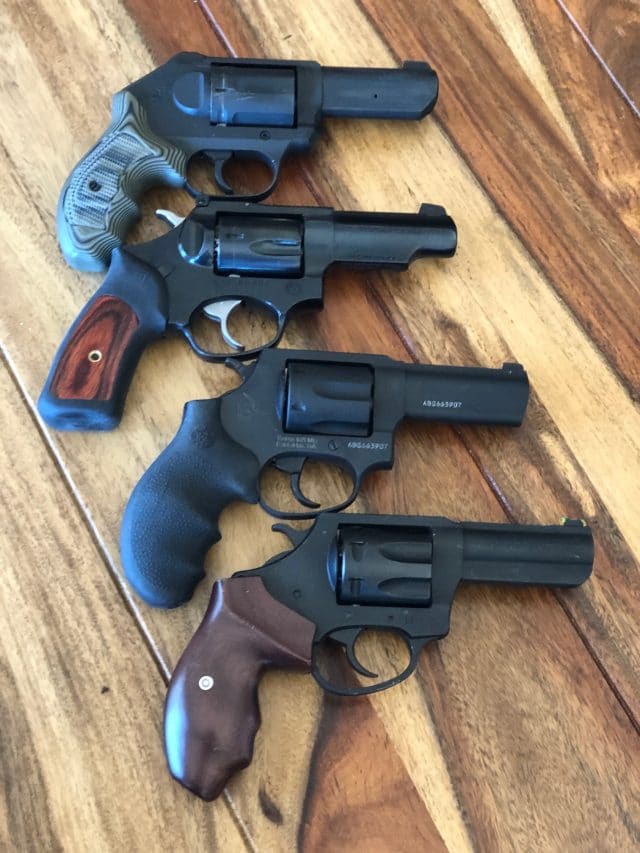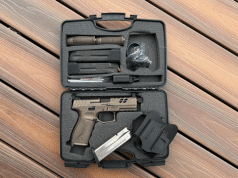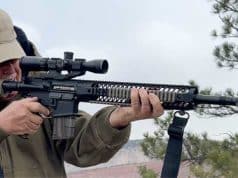- Height (inches): 5.0
- Weight (ounces) with empty cylinder: 23
- Length (inches): 6.62
- Width (inches): 1.39
- Cylinder capacity: 6 rounds
- Action: DAO
- MSRP: $999
I have to admit I came late to the Kimber K6 party. Although my friend Grant Cunningham — one of the masters of the small revolver — hammered out the details of the first K6s introduced in 2016, and I shot those first K6s with full-bore .357 loads at the 2016 SHOT Show without any evidence of spontaneous combustion, it wasn’t until a couple of years ago that I got one of my own.
Grant, of course, absolutely and unequivocally knows what he’s doing, and that’s why there is much to like in the K6. First and foremost, it is the least painful small .357 revolver on earth, thanks to weight, grips and, heaven help us all, ergonomics. Trigger pull is excellent at a little over 10 pounds and, true to Kimber advertising, doesn’t stack at the end.
The 3-dot night sights are the best of this particular four-gun selection and, in the macro sense, second only to the dovetail-mounted Novaks on the Wiley Clapp SP101. The big push-in cylinder release is easy to run fast. I like the matt black finish over stainless, and I think I like the G-10 grips, which are not only cut for excellent concealment, but they’re grippy without feeling like a wood rasp.
I’ve been open carrying this gun while waiting for my new CCW to arrive in a superb Kirkpatrick Leather hi-ride holster with .357 125-gr JHPs, and I couldn’t be any happier. The Fiocchi 125s shoot to point-of-aim at 10 yards
2) Lipsey’s/Ruger SP101 .357
- Height (inches): 4.5
- Weight (ounces) with empty cylinder: 27
- Length (inches): 8
- Width (inches): 1.4
- Cylinder capacity: 5 rounds
- Action: DA/SA
- MSRP: $719
- Height (inches): 4.8
- Weight (ounces) with empty cylinder: 15.5 (aluminum); 23.5 (steel)
- Length (inches): 7.5
- Width (inches): 1.41
- Cylinder capacity: 6 rounds
- Action: DA/SA
- MSRP: $425
- Height (inches): 5.25
- Weight (ounces) with empty cylinder: 22
- Length (inches): 7.93
- Width (inches): 1.37
- Cylinder capacity: 7 rounds
- Action: DA/SA
- MSRP: $438
Okay, let’s deal with the elephant in the room, the caliber, .32 H&R Magnum. The round was created in 1984 in joint venture by Harrington & Richardson and Federal, with the idea of jacking up the old .32 S&W Long into a modern and relatively serious cartridge. The goal was .38 Special ballistics in a package that would allow 6, rather than the more typical 5, rounds in a snub nose revolver cylinder.
I have a lot of experience with the .32 Mag because my second snubbie (or first if you discount my 4-inch S&W Regulation Police) was a butt-ugly H&R in that caliber. I immediately started loading 98-grain lead bullets for the gun, which was to be honest a quantum leap over the .38 S&W that I’d been loading. There are pellet guns that are a quantum leap over the .38 S&W.
When my Sweetie decided to get into Cowboy Action Shooting, I stumbled on a pair of Ruger birdshead-gripped Single Sixes in .32 Mag, and she began shooting them in competition using the heavier 115-gr bullets intended for 32-20s because the heavier bullets rang the steel a little better.
So why would a modern company close .32 H&R Mag over the more modern and more powerful .327 Federal Magnum? I called Nick Eckerd, the President of Charter Arms and an old friend, and asked him. “Because,” he said, “the .327 Federals were just too hot. And we wanted the seventh round in the gun.” And yes the much higher pressures of the .327 Federal Magnum would probably have demanded a 5-shot cylinder.
This Professional was a surprise to me. I have had and presently have a couple of Charter Arms guns and have generally liked them. But the Professional (and, yes, I wince every time I wrote that name) is a clear step up. It has a steel frame with a black nitrate finish, green fiber optic front and a beautiful set of walnut grips. Trigger pull is hanging in at about 11.5 pounds, but my experience with Charters is the trigger pulls smooths out and lightens up somewhere around 300 rounds. If you ask a gunsmith to clean up a Charter trigger, chances are he/she will run around with his/her fingers in his/her ears shouting, “LALALALA,” They’re a bit of a pain to work on.
With the 115-gr cowboy loads, it just stacks bullets in a single hole at 7 yards. Recoil is essentially no big.
The Net Net
So, how to sum this up…the net net, if you will? Let’s run through the bullet points:
• Three inch revolvers are always going to be easier to shoot than their shorter-barreled brethren, because physics. The guns are a little heavier, and a little heavier means a little more soaking up recoil. This functionally doesn’t make any difference if you’re talking about .38 Special, even +P, or .32 H&R Magnum, but it does when you start talking about .357 Magnum. However, modern ammo design has gone a long way to alleviate the .357 issue. If you check out the TRIGGERED episode this week, you can see me shooting the SP101 3-inch and the Kimber K6 with Fiocchi 125-gr JHPs, your baseline .357 Magnum load. Note that my hand didn’t explode.
• There-inch snubs are holster, not pocket, guns. That extra inch makes a big difference. I suppose eom of you will send me emails that you routinely carry 3-inch whatever in your coat pockets. Well, okay. I have, too, but it was more of an exigency than an everyday solution. Note that the adjustable sights on the SP101 means it may not fit your SP101 3-inch holsters…it didn’t fit mine, except for Simply Rugged.
• Buy ammo (well, if you can ever buy ammo again, that is) that is designed for the gun. The Buffalo Bore 110-gr standard pressure .38s designed for low flash and low recoil were cupcakes in the Taurus 856, printing maybe an inch high at 10 yards. I wouldn’t hesitate to carry that load.
• Favorites? Hard to say. I would default to the SP101, but I suspect that it is because I have drastically more time behind an SP101 than the other guns, and that makes a difference. I have been carrying the K6 for a while since my CCW expired and I while was waiting for the new card I had to open carry, and the K6 with Buffalo Bore .357s in the Kirkpatrick OWB fit the bill.
John Taffin has spent years talking about the “perfect packing’ pistol.” I am lucky enough to live in a place where a perfect packing pistol has a lot of utility. I think that the 3-inch revolver fits that category better than any of the other alternatives I have tried. I love the 3-inch midframes like the GP100 or the S&W Model 19s and some of the 686s, but you have the added weight/size penalty. I can tell you from experience that carting around an SP101 or a K6 is one of those rare instances where the reality actually matches “it disappears on your hip” gunwriter shibboleth. As I said, I carted the K6 for more than a month and once I put it on never gave it another thought.
In the TRIGGERED video companion piece, I talk about the Galco Combat Master holster, which is an excellent choice for an OWB. If you’re willing to go for the high priced spread, so to be (and yes, I date myself with that line from a commercial), Doc Barranti’s Carry Confidence CCR is the best there is, so my knowledgeable friends tell me.
I have a great OWB holster for the Ruger LCR from Ritchie Holsters, and, of course, I would be hugely remiss if I didn’t mention my good friend Rob Leahy at Simply Rugged and his wonderful Silver Dollar Pancake…quality at a reasonable price!
The 3-inch little revolvers have a lot going for them, and they’re perfectly suitable for a lot of different jobs, from concealed carry to schlepping around in the woods. Besides, everybody needs another revolver!





Thanks my friend. Hope you are well.